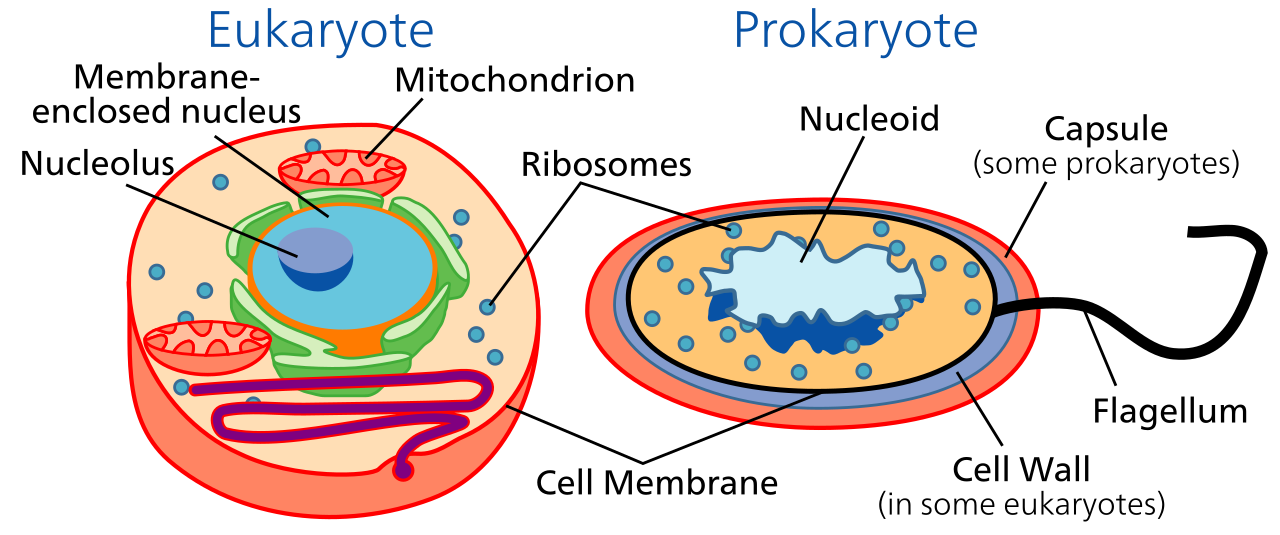Tejas Bhartiya
Tejas Bhartiya
Skills you’ll gain in this topic:
- Explain how compartmentalization improves cellular efficiency and specialization.
- Describe how organelles create environments suited for specific processes.
- Relate the structure of eukaryotic organelles to their cellular roles.
- Predict how cells manage resources through compartmentalization.
- Analyze the role of compartmentalization in supporting metabolic pathways.
Cell Compartmentalization
One of the major differences between eukaryotes and prokaryotes is that eukaryotes compartmentalize their internal processes in membrane-bound organelles.
In eukaryotic cells, after RNA is made from DNA in the process of transcription, it moves to the ribosome to go through the process of translation. The RNA has to move out of the nucleus to either a free-standing ribosome or to the rough endoplasmic reticulum. In addition, ATP is made from mitochondria, which has its own internal membrane.
In prokaryotes, RNA is converted to proteins right after being made from DNA, as they do not have a nucleus or endoplasmic reticulum. This will lead to more differences in transcription and translation, which will be discussed in a later unit.
By reducing the amount of competing space and surface area, and also reducing the amount of competing reactions, eukaryotic cells are able to be more efficient than prokaryotic cells.
Internal Membranes
A key theme for this unit has been increasing surface area to volume ratio. Internal membranes within the cell, such as mitochondria or chloroplasts, make cellular processes easier by minimizing competing interactions and by increasing the surface area to volume ratio. Think of it this way: if you already use the cell membrane for transporting stuff, there's probably not enough room for ATP synthesis. So this ATP synthesis process is done on a separate membrane, within the organelles. This also increases the surface area to volume ratio because it gives more opportunities to fold the membrane.
🎥 Watch: AP Biology - Cell Compartmentalization

Image courtesy of Wikipedia
<< Hide Menu
Tejas Bhartiya
Tejas Bhartiya
Skills you’ll gain in this topic:
- Explain how compartmentalization improves cellular efficiency and specialization.
- Describe how organelles create environments suited for specific processes.
- Relate the structure of eukaryotic organelles to their cellular roles.
- Predict how cells manage resources through compartmentalization.
- Analyze the role of compartmentalization in supporting metabolic pathways.
Cell Compartmentalization
One of the major differences between eukaryotes and prokaryotes is that eukaryotes compartmentalize their internal processes in membrane-bound organelles.
In eukaryotic cells, after RNA is made from DNA in the process of transcription, it moves to the ribosome to go through the process of translation. The RNA has to move out of the nucleus to either a free-standing ribosome or to the rough endoplasmic reticulum. In addition, ATP is made from mitochondria, which has its own internal membrane.
In prokaryotes, RNA is converted to proteins right after being made from DNA, as they do not have a nucleus or endoplasmic reticulum. This will lead to more differences in transcription and translation, which will be discussed in a later unit.
By reducing the amount of competing space and surface area, and also reducing the amount of competing reactions, eukaryotic cells are able to be more efficient than prokaryotic cells.
Internal Membranes
A key theme for this unit has been increasing surface area to volume ratio. Internal membranes within the cell, such as mitochondria or chloroplasts, make cellular processes easier by minimizing competing interactions and by increasing the surface area to volume ratio. Think of it this way: if you already use the cell membrane for transporting stuff, there's probably not enough room for ATP synthesis. So this ATP synthesis process is done on a separate membrane, within the organelles. This also increases the surface area to volume ratio because it gives more opportunities to fold the membrane.
🎥 Watch: AP Biology - Cell Compartmentalization

Image courtesy of Wikipedia

© 2025 Fiveable Inc. All rights reserved.